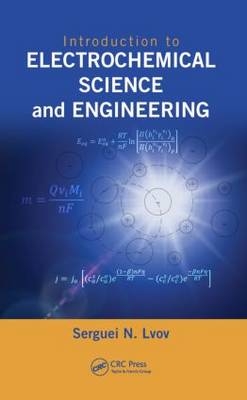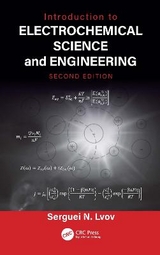
Introduction to Electrochemical Science and Engineering
Crc Press Inc (Verlag)
978-1-4665-8285-9 (ISBN)
- Titel erscheint in neuer Auflage
- Artikel merken
Inspired by the author’s more than ten years of experience teaching undergraduate electrochemistry-related courses at Penn State University, this essential text:
Ensures a fundamental knowledge of the core concepts of electrochemical science and engineering, such as electrochemical cells, electrolytic conductivity, electrode potential, and current-potential relations related to a variety of electrochemical systems
Develops the initial skills needed to understand an electrochemical experiment and successfully evaluate experimental data without visiting a laboratory
Provides more than 360 conceptual and numerical problems distributed over nine quizzes and nine video-based assignments
Contains a number of illustrative case studies related to novel electrochemical energy conversion systems
Promotes an appreciation of the capabilities and applications of key electrochemical techniques
Solutions manual and electronic figure files available with qualifying course adoption
Introduction to Electrochemical Science and Engineering is an ideal textbook for undergraduate engineering and science students and those readers in need of introductory-level content. Furthermore, experienced readers will find this book useful for solidifying their electrochemical background.
Serguei N. Lvov is a professor of energy and mineral engineering, a professor of materials science and engineering, and a director of the Electrochemical Technologies Program at the EMS Energy Institute of The Pennsylvania State University, University Park, USA. His areas of research include electrochemistry, thermodynamics, material sciences, and environmental sciences. He is the author of more than 100 peer-reviewed papers, 2 books, 6 book chapters, and 2 US patents.
Acknowledgments
Introduction
Author
Electrolyte Solutions
Objectives
Formation of Electrolyte Solutions
Electrolyte Concentration and Concentration Scales
Conversion Equations for the Concentration of Solutions
Chemical Potential
Standard Chemical Potential and Activity Coefficient on Different Concentration Scales
Chemical Potential of Solvent and Solute in Electrolyte Solution
Activity and Activity Coefficient
Activity Coefficient of Electrolyte and an Ion
Chemical Potential and Gibbs Energy of Formation
Debye–Hückel Theory of Dilute Electrolyte Solutions
Calculation of Activity Coefficient Using Debye–Hückel Theory
Calculated and Observed Activity Coefficients
Mean Activity Coefficient in Concentrated Aqueous Solutions
Speciation in Weak Electrolytes
pH of Aqueous Solutions
pH of Buffer Solutions
Suggested pH of Standard Solutions
Summary
References
Electrochemical Cells
Objectives
Basic and Derived SI Units
Electrochemical Cell (System)
Electrolytic and Galvanic Cells
Electrochemical Diagrams (Traditional)
New Electrochemical Diagrams
Faraday’s Law of Electrolysis
Fundamental Constants
Water Electrolysis
Ohm’s Law
Kirchhoff’s Law
Electrochemical Cells with Transfer
Daniell Cell in Galvanic Mode
Daniell Cell in Electrolytic Mode
Cell Potential-Current Dependence
Summary
References
Electric Conductivity
Objectives
Types of Electric Conductivity
Significance of Ion Conductive Materials for Electrochemical Engineering
Origin of Ionic Conductivity
Conductance and Conductivity of an Electrolyte
Electric Conductivity of Pure Water
Conductance by Direct and Alternating Currents
Electrode/Electrolyte Interface
Extracting the Electrolyte Resistance
Conductivity Measurements
Molar and Equivalent Conductivity
Kohlrausch’s Law and Limiting Conductivity
Additivity of Electrolyte Limiting Conductivity
Transport Numbers
Diffusion and Hydration of Ions in Infinitely Diluted Solution
Proton Conductivity
Walden’s Rule
Summary
References
Equilibrium Electrochemistry
Objectives
Equilibrium Thermodynamics and Electrochemistry
Equilibrium between Phases in Electrochemical Cell
Galvani Potential of the Hydrogen Electrode
Gibbs Energy of Reaction and Equilibrium Electrode Potential
Nernst Equation
Standard Hydrogen Electrode
Ag/AgCl Reference Electrode
Harned Cell
Electrochemical Series
Calculation of Equilibrium Potential of Daniell Cell
Nernst Equation for Typical Electrodes
Another Example of Estimating of E0 and E
Calculation of E0 at Elevated Temperature
Temperature Dependence of the Standard Electrode Potential
Temperature Dependence of Open Circuit and Decomposition Potentials
Potential-pH (Pourbaix) Diagram
Summary
References
Electrochemical Techniques I
Objectives
Potentiometric Measurements
Commercial Ag/AgCl Reference Electrode
Commercial Calomel Reference Electrode
pH Glass Electrode
Liquid Junction (Diffusion) Potential
Henderson Equation
Calculation of the Diffusion Potential
Minimization of the Diffusion Potential in a Cell
Kinds of Potentiometry
Measurement of the Standard Electrode Potential
Measurement of pH
Combined pH/Reference Electrode Sensor and pH Meter
Summary
References
Electrochemical Kinetics
Objectives
Concept of Electrochemical Cell Overpotential
Overpotential of a Single Electrode
Polarization Curve of a Single Electrode
Mechanism of Electrochemical Reaction
Charge Transfer Overpotential: Butler–Volmer Equation
Symmetry Coefficient, β
Exchange Current Density, jo
Experimental Data on the Exchange Current Density and Symmetry Coefficient
Simplifications of Butler–Volmer Equation
Tafel Equation
Volcano Plot
Concentration Overpotential
Mass Transfer Overpotential
Generalized Butler–Volmer Equation
Summary
References
Electrochemical Techniques II
Objectives
Transport Processes in Electrochemical Systems
Current–Time Dependence at Constant Potential (Potentiostatic Regime)
Concentration–Time Dependence at Constant Current (Galvanostatic Regime)
Effect of Hydrodynamics (Fluid Mechanics) on Electrochemical Reaction
Rotating Disk Electrode and Limiting Current
Rotating Disk Electrode Electrochemical Cell
Cyclic Voltammetry Background
Cyclic Voltammetry of Fe(CN)3–6 /Fe(CN)4–6 Couple
Summary
References
Electrochemical Energy Conversion
Objectives
Main Types of Electrochemical Energy Conversion Systems
Principle Design of a Fuel Cell
Main Kinds of Fuel Cells
Electrochemistry of Full Cells
Three-Phase Boundary Issue
New Electrochemical Diagrams for Fuel Cells
Polarization Curves of PEMFC and SOFC
Efficiency of Fuel Cell vs. Heat Engine
Total Efficiency of Fuel and Electrolytic Cells
Heat Balance in Fuel and Electrolytic Cells
Summary
References
Electrochemical Corrosion
Objectives
Origin of Electrochemical Corrosion
Pourbaix Diagram in Corrosion Science
Polarization Curve of Metal Corrosion
Corrosion Potential and Current Density
Rate of Electrochemical Corrosion
Corrosion Protection
Kinds of Corrosion
Summary
References
Data Section
Codata Values of the Fundamental Physical Constants
Physical Constants of Inorganic Compounds
Standard Thermodynamic Properties of Chemical Substances
Thermodynamic Properties as a Function of Temperature
Thermodynamic Properties of Aqueous Ions
Ionization Constant of Water as a Function of Temperature and Pressure
Electrical Conductivity of Water
Electrical Conductivity of Aqueous Solutions
Standard KCl Solutions for Calibrating Conductivity Cells
Molar Conductivity of Aqueous HCl
Equivalent Conductivity of Electrolytes
Ionic Conductivity and Diffusion at Infinite Dilution
Electrochemical Series
Dissociation Constants of Inorganic Acids and Bases
Dissociation Constants of Organic Acids and Bases
Activity Coefficients of Acids, Bases, and Salts
Mean Activity Coefficients of Electrolytes
Concentrative Properties of Aqueous Solutions
Aqueous Solubility of Inorganic Compounds at Various Temperatures
Solubility Product Constants
Solubility of Common Salts at Ambient Temperatures
Thermophysical Properties of Water and Steam at Temperatures up to 100°C
Vapor Pressure and Other Saturation Properties of Water at Temperatures up to 100°C
van der Waals Constants for Gases
Vapor Pressure of Saturated Salt Solutions
Electrical Resistivity of Pure Metals
Composition of Seawater and Ionic Strength on Molality Scale at Various Salinities S in Parts per Thousand
Error Function
Periodic Table of Elements
Appendix A: Quizzes
Appendix B: Video-Based Assignments
Index
| Erscheint lt. Verlag | 17.12.2014 |
|---|---|
| Zusatzinfo | 41 equations; 16 Tables, black and white; 101 Illustrations, black and white |
| Verlagsort | Bosa Roca |
| Sprache | englisch |
| Maße | 156 x 234 mm |
| Gewicht | 612 g |
| Themenwelt | Naturwissenschaften ► Physik / Astronomie |
| Technik ► Umwelttechnik / Biotechnologie | |
| ISBN-10 | 1-4665-8285-5 / 1466582855 |
| ISBN-13 | 978-1-4665-8285-9 / 9781466582859 |
| Zustand | Neuware |
| Haben Sie eine Frage zum Produkt? |
aus dem Bereich



